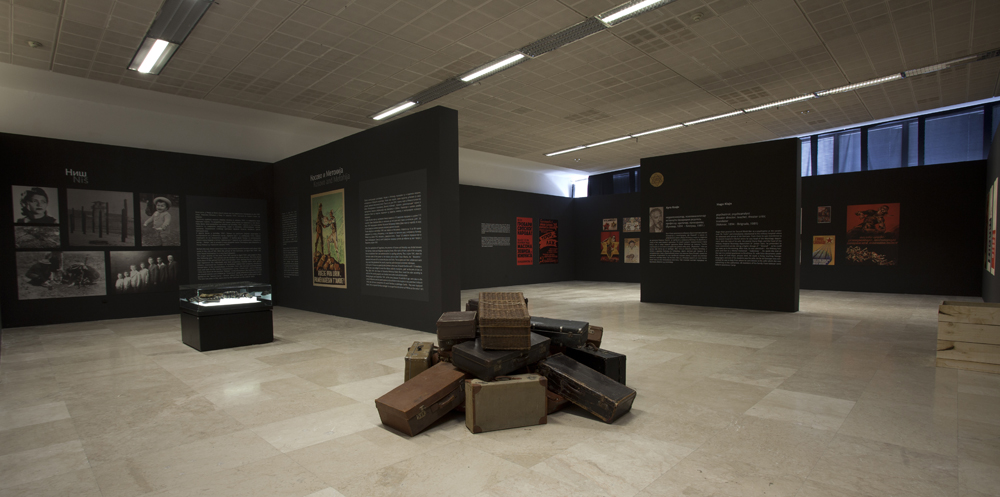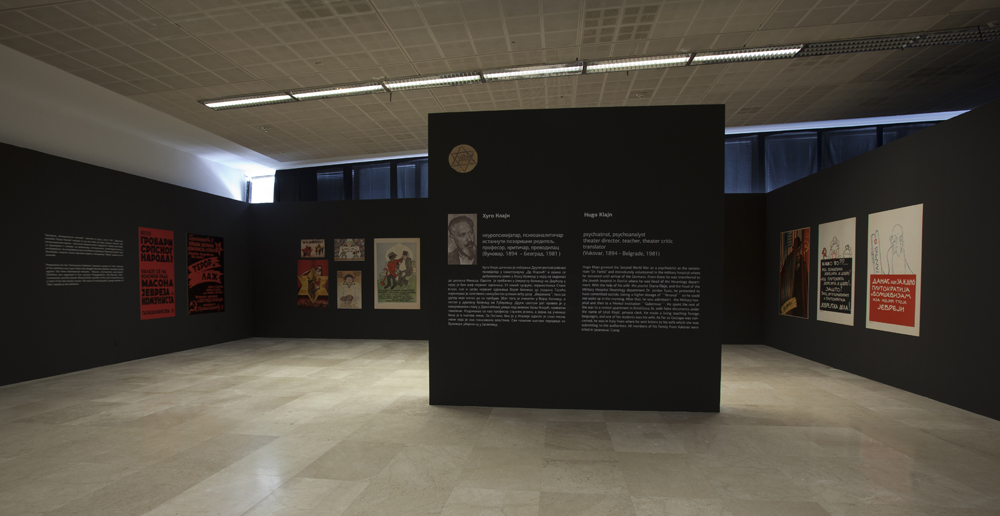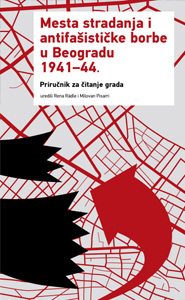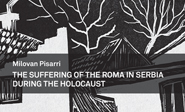author: Milovan Pisarri, historian
download .doc
On 1 April, after more than two months, the exhibition “The Holocaust in Serbia 1941-1944” was closed. It has been roughly ten days since, therefore, I find it is time to exchange our impressions and opinions on how the authors addressed the Holocaust in Serbia, and ascertained whether it was presented in an appropriate manner to the wider audience. Being a historian dealing with the issue and the editor of the blog “A visit to Staro sajmište”, I believe it is my responsibility to share my reflections with you here.

Exhibition view “Holocaust in Serbia. 1941-1944” at the Museum of Yugoslav History, January 27th – April 1st 2012. Photo: MIJ
The exhibition was opened in the Museum of Yugoslav History, on 27, January 2012, on the International Holocaust Remembrance Day, and it was sponsored by the Government of the Republic of Serbia. The opening of such an exhibition was of great significance for at least two reasons: firstly, as it is first exhibition of its kind, that is, the first exhibition on the Holocaust in Serbia, and secondly, as it publicly signified the official Serbian participation in the Task Force for International Cooperation on Holocaust Education, Remembrance, and Research (ITF, www.holocausttaskforce.org). Additionally, three hours before the exhibition opening, on 27. January,a commemoration for the victims of the Holocaust had been held on the Staro sajmište site. It was attended by the President of the Republic of Serbia, Boris Tadić, the Mayor of Belgrade, Dragan Đilas, the Federation of the Jewish Communities of Serbia representatives, ITF Chair, Karel De Beer, Israeli and the Netherlands’ ambassadors to Serbia, and many other officials.
The material used in the exhibition on the Holocaust in Serbia, as well as the accompanying texts, were chosen by historians Momčilo Mitrović PhD, Aleksej Timofejev PhD, and Jelena Petaković MA, all from the Institute for Recent History of Serbia. The exhibit was set up by architect Ozarija Marković Lašić. As it was quoted in the press releases, besides the Government and various ministries, ten other institutions both from the country and abroad took part and contributed in the production of the exhibition. One of these institutions was also Yad Vashem, the world centre for documentation, research, education and commemoration of the Holocaust.

Exhibition view “Holocaust in Serbia. 1941-1944”: posters shown at the “anti-Masonic” exhibition from 1941/42. Photo: MIJ
The space at disposal was divided into several separate rooms, displaying the most important questions in relation to the Holocaust in Serbia: the position of the Jewish community prior to the World War II, anti-Semitism and anti-Jewish measures proclaimed in October 1940, in the Kingdom of Yugoslavia, the occupation by German forces and the imposing of the Nazi racial laws, the beginning of the persecutions, the extermination of Jews in Serbia under German occupation and the concentration camp Sajmište, the posters featured at the anti-Masonic exhibition from 1941/42, the extinction of Jews in other parts of Serbia at the time under the occupation of the German allies (in Bačka, under the Hungarian rule, in Srem under The Independent State of Croatia’s rule, and in a part of Kosovo, under Italian rule), the people of Jewish origin who had survived the Holocaust, Jewish participation in the war, and finally, the state of the existing Holocaust memorials. Taking a stroll through these rooms, thevisitor finds other equally important segments of the exhibition, although of a somewhat different character: documentaries chronicling the accounts of the survived and presenting the Holocaust in Serbia, huge photographs of those who suffered and died, camp cell reconstruction from the camps in Banjica and Crveni krst in Niš, the names of Righteous among the Nations in Serbia, etc.
The abundance of the material exhibited and a vast exhibition space, implied, or so it seemed to me, a long-term work spreading over months, as it is usually the case with all the events of such proportions: starting with the search for the adequate material in the institutions in the country and abroad, up until its copying, arranging, writing up accompanying texts and taking advice from other experts with the aim of obtaining feedback information on one’s work, the before-mentioned cooperation with more than fifty institutions, and of course, quoting authors who dealt with the issue of the Holocaust in Serbia the most.
Due to that, the realisation of the exhibition had not been an easy task, and this is something that should be acknowledged without hesitation. The lack of initiatives of this kind in the past must have presented a severe obstacle to the authors, and it that sense, a great responsibility they had to cope with as well, in the course of material selection and its presentation to the wider public. It is exactly this awareness of responsibility which makes a historian ask himself the following questions while creating and working on his project: What is my aim? What issues do I want to address? What is my contribution to the subject? What is the direction of further research? And most importantly: What are the effects of my work?
Of course these questions are of great significance when it comes to creating a work intended for the trained eye and the expert, professional audience. However, they should be of even greater importance in each phase of the work’s presentation to the wider audience, since it is actually then that the social responsibility of the historian is demonstrated. In fact, when the exhibition in question is of historical and educational character, a historian must know that the people who will be seeing, listening or reading the work, in the majority of cases, will be acquiring a certain knowledge of the segments of history presented to them through the material selected and the methodology of the exhibition’s author for the first time. Therefore, the author must always bear in mind the responsibility he holds: since a person who enters an exhibition space with no previous knowledge of the topic, will come out with a huge amount of information, most of it being exactly those the author had consciously chosen to pass over.
In the case of the exhibition on the Holocaust, the author has to be aware of the fact that among the visitors who do not have a wider knowledge of the issues such as the Jewish suffering in Serbia during the World War II, the majority will be precisely made up of high school students, that is, young people in their formative years, when their views and opinions are shaped.
The problem of selective memory
The fact that the exhibition on the Holocaust is of remarkable importance stands to reason. There is also no doubt about the fact that the Jewish municipalities’ representatives are pleased that finally, seventy years after the systematic destruction of their families, friends, and their communities, the Government of the country they live in, has eventually chosen to do something about it. Nevertheless, it is evident that the exhibition, at least in some of its aspects, has endeavoured to save the honour and face of the Serbia then and now.
Having said that, I would like to draw the attention to the problem the exhibition, despite its outstanding merit, still holds. After the laurels it won, the exhibition deserves some criticism.
The problem lies in the fact that the message it conveys is clear, and unfortunately, in perfect accordance with the general messages sent out for years by all the countries where any kind of collaborationism existed: the Germans are held responsible for the Holocaust, and they are the only ones to blame and hold accountable. There had been some collaborationists (the authors of the exhibition put emphasis on Dimitrije Ljotić, whom the today’s Chetniks dislike and distance themselves from), however, one can conclude from the accompanying texts, that the authorities, police and individuals in this country had not played a more significant role.
The fact that the Germans are to be held responsible for the Holocaust goes without saying: however, since it is a well-known fact from a long time ago, we should stop hiding behind it for once and start talking about those who were their faithful allies in the execution of the genocidal plan and those who shared the same racial ideology and a sincere wish to have the Jews and Roma people exterminated.
We have to talk about and discuss the responsibility of our own ancestors, not only the Germans’ or our neighbours’ responsibility. To constantly talk about and discuss over and over again theirs, is not only ‘politically correct’, since it does not upset anyone, but it also stands for continuity between nationalist political speech and the historical revisionism, the two central factors accountable for general acceptance of fascist models in the social and economic relations.
To only talk about the others, and only occasionally and very vaguely mention the role of Serbian authorities at the time, means to apply a kind of selective memory, in other words, make a decision not to show certain points, knowing that a high school student visiting the exhibition organised by the Government, will find it hard to believe that some of his ancestors might have taken part in the Holocaust. How could a teacher, even if he would, deny the truth propagated by the state institutions? Is a regular teacher’s word worth more than the President’s, a minister’s or the word of someone who holds a PhD in history?
Actually, resorting to selective memory is evident in almost every exhibiting room.
At the beginning of the exhibition, any kind of explanation of the nature of anti-Semitic laws passed in October 1940 remains unmentioned. Nevertheless, a kind of excuse for the same laws and their introduction is cited: “The legal measures against Jews were established in the somewhat altered political situation. These measures pertained to various restrictions which were not always consistently practiced and adhered to.” The novelties of anti-Semitic character without any key explanations are mentioned – the explanations, which would show that although anti-Semitism and philo-Germanism were non-existent among the people, the same could not be said of the ruling political, economic and cultural elite. Naturally, not a word is spoken of the controversial figure of bishop Nikolaj Velimirović, whose writings contain anti-Semitic ideas, while his support of Hitler, as well as Dimitrije Ljotić, is very well-known, straightforward and public. Despite it all, in 2003, Serbian Orthodox Church proclaimed him a saint. Nothing was said of the responsibility of Pavle Karađorđević, who has been rehabilitated recently.
Coinciding with their decision to simply skip these problematic moments, the authors resolve to present the pre-war Jewish community in a way I find rather alarming. Namely, one of the first sentences goes: “As it happened, the Jews were predominantly bourgeoisie engaging in industry, trade and banking, where their influence was often dominant and crucial.”
It has to be stressed that such a categorisation of Jews is absolutely unacceptable. It represents a terrible stereotype which was the basis for Goebbels’ anti-Semitic propaganda in Nazi Germany. Additionally, one really wonders at the fact that the authors decided to present Serbian Jews to the public in such a way, placing the emphasis on class categorisation, when it is commonly known that the Jewish community in Serbia had been diverse, just as any other national community. For example, it is well-known that a lot of poverty-stricken Jews lived in Dorćol.
Class categorisation evident in the text is confirmed with the accompanying photographs, through which one gains an impression that the Jews were really the ones pulling the strings of Serbian industry and economy on the whole at the time.
Unfortunately, I have to stress that such an outset of the exhibition is extremely problematic, precisely because one should obtain the basic means for the comprehension of the material in the first room, in order to easily understand the material in all the other rooms. The visitor will therefore, enter the second room lacking the essential information, together with a distorted view of Serbian Jews.
In the course of the entire exhibition the role of the collaborationists – from Nedić’s authority to the Belgrade police force led by Dragomir Drago Jovanović, special police forces’ commissary Jovan Nikolić, and many others – is simply omitted, even when it is the Serbian police officers (and even Chetniks), who appear on the exhibited photographs.
There are numerous sources to show to what extent their role was crucial. Here we will cite but two: Olivera Milosavljević’s publication entitled Potisnuta istina. Kolaboracija u Srbiji 1941-1944, (Repressed truth. Collaboration in Serbia 1941 – 1944) which can be found here: http://www.helsinki.org.rs/serbian/doc/Ogledi07.pdf, and an article by Filip David Ćorave bake published in February edition of Jewish review (Jevrejski pregled), which can be found here: http://www.savezscg.org/files/jevrejski-pregled-02-2012.pdf.
As opposed to silence when it comes to the role of Serbian collaborationists, a kind of emphasis is certainly perceived when it comes to the role of other collaboration forces. In this way, there was enough space at the exhibition for Xhafer Deva, an Albanian from Kosovska Mitrovica, who openly supported the Nazis and played an important role in the persecution of the local Jewish community (however, even there, just like in the other regions under the German occupation, it was Germans who decided when and how to exterminate Jews, not Xhafer Deva). On the other hand, there is no mention of the fact that certain parts of Kosovo under the Italian rule were a safe region, not only for the local Jews, but also for those Jews who found refuge there, escaping various parts of the country looking for salvation. Additionally, there is no mention of the fact that in March 1942, in Priština, exactly in a situation where the Italian authorities had given in under the Nazi pressure and gave over the first group of 51 Jewish refugees, the Albanian Ministry of internal affairs intervened and saved the rest of the refugees.
Errors
The second great problem with the exhibition we have to direct your attention to is the large amount of errors in exhibiting the photographs and the accompanying texts. While the issue of selective memory is up to a point liable to discussion and different attitudes, in this case the errors are a fact and there is no discussion about it. The errors are simply there. Some of the major ones will be cited here:
Šoa – The first intolerable mistake is, as Nikola Radić Lucati has noticed, a misspelt word in Hebrew – ‘Šoa’ – it was written backwards.
Figures – The first number we come across at the very beginning of the exhibition tells us that prior to the World War II, there had been 39,272 Jews living in Serbia, out of whom 4,772 survived. However, between the first and the second room, it says that 33,579 Jews lived in Serbia, out of whom 27,024 were murdered, which leaves us with approximately 6,500 surviving Jews.
Kladovo transport – In the accompanying text, it is first said that men died during the ‘bloody march’ in September 1941, while later on we find out that they were shot in October 1941.
Crematory – Although it is the symbol of the Holocaust, in Serbia there were none. Jews were executed either by being shot (men), or killed in death vans (women, children, the elderly and the sick). A project to build a crematory in Sajmište and later on in Banjica, was a topic in 1943, that is, when the Holocaust in Serbia had already been finished. One cannot place a crematory project draft which says 1943, next to the photo of the concentration camp for Jews dating from 1941.
Intern photographs – One of the photographs shows the Sajmište interns. However, it is not Jews, but the interns of the detention camp in Zemun, that is, the camp for imprisoned partisans (at one point, for Chetniks, too), political prisoners and forced labourers, open from 1942 till 1944, situated on the same grounds as the Jewish camp before it.
The photograph of the camp authorities – As it is well-known, a photograph which was for a while presented as the photo of the Sajmište camp authorities, is actually not genuine. The original photograph, which shows the period of the camp after the Jew extermination, can be viewed here: http://www.open.ac.uk/socialsciences/semlin/sr/sajmiste-anhaltelager.php.
Grammar mistakes and typographical errors – Since this is an exhibition of historical and educational character, I find it unacceptable to have grammar and typographical mistakes in the accompanying texts.
Conclusion
Organising the first exhibition on the Holocaust in Serbia is certainly an event of exceptional importance. However, precisely due to its significance, the exhibition should have been organised more meticulously, with a more mature approach to that historical period of the 20th century, using the experience of other countries, following the trends in the contemporary perceptions of the Holocaust, and of course, clearly and explicitly pointing out the responsibility of the domestic institutions and individuals, since it is something not to be concealed.
To stay tacit about the role of Serbian collaborationists means to be placed in the position of those perpetuating the crime: selective memory which erases the responsibility of our ancestors loyal to Nazism, makes us all revisionists and does not allow us a peaceful confrontation with the past. Additionally, it also opens up a space for the same hate patterns to reappear in our society without any hindrance, since we are deprived of the possibility to recognize them, still thinking that only the Germans are to be held responsible for the Holocaust, racial ideology and socially accepted normalcy according to which, to kill innocent people, women and children above all, because they belong to a different nationality, or because we hold them responsible for the misery (real or imaginary), our people suffered, is not considered a sin.
Herby I invite all those interested to email us their impressions and critical views of the exhibition, as well as the mistakes you may have noticed. Advice to the exhibition’s authors and organisers, and anything else you might find important to mention is more than welcome.
I find it highly important that our opinions and the list of errors should be collected and sent to the authors of the exhibition, the President of the Republic and the Ministries which supported the initiative, ITF, Yad Vashem and all the organisations that have taken part in the making of the exhibition, hoping that the mistakes would be corrected and that the next event about the Holocaust will be organised in the best way possible.


